
Toyota Aygo X Review

Introduction
It seems car manufacturers are running out of things they can turn into SUVs. First, it was family hatchbacks that had grown off-roady bits. Then proper SUVs had their roofs chopped off at the rear to create a generation of SUV coupes.
Now, it seems we are changing tiny city cars into SUVs, too. That is the aim of Toyota, which has taken its Aygo, jacked it up a little bit, added some cladding to the exterior and turned it into the Toyota Aygo X.
Select's rating score* - 3.6 / 5
At A Glance
The ‘X’ is pronounced ‘cross’, by the way, which, although not obvious, will come as no surprise to those familiar with crossovers. These vehicles add some rugged, rural appeal to everyday family cars.
This latest take from Toyota is an idea that stems back to a concept car – the Aygo X Prologue. The Japanese manufacturer announced this model around a year ago, but it is built on the same TNGA GA-B platform as the Yaris and the Yaris Cross.

Toyota intends for the Aygo X to eventually replace the standard Aygo completely. So, it seems the humble city car’s days are numbered.
In terms of looks, the X appears to be a more robust Aygo. And, at first glance, you could think it was an electric car as the grille seems to be covered up. Instead, the lower grille is much bigger than normal and emerges underneath the Toyota badge like a goatee, with two fog lights sitting at each end of it. Part of this shape is created thanks to the off-road cladding, with a silver lip running along the bottom.
The cladding extends around the side, accentuating the wheel arches and the side skirts. The rear windows are angled, too, meaning they are much thinner at the rear compared with the front. Meanwhile, the bodywork is sculpted such that the rear wheel housing seems to stick out from the sides.
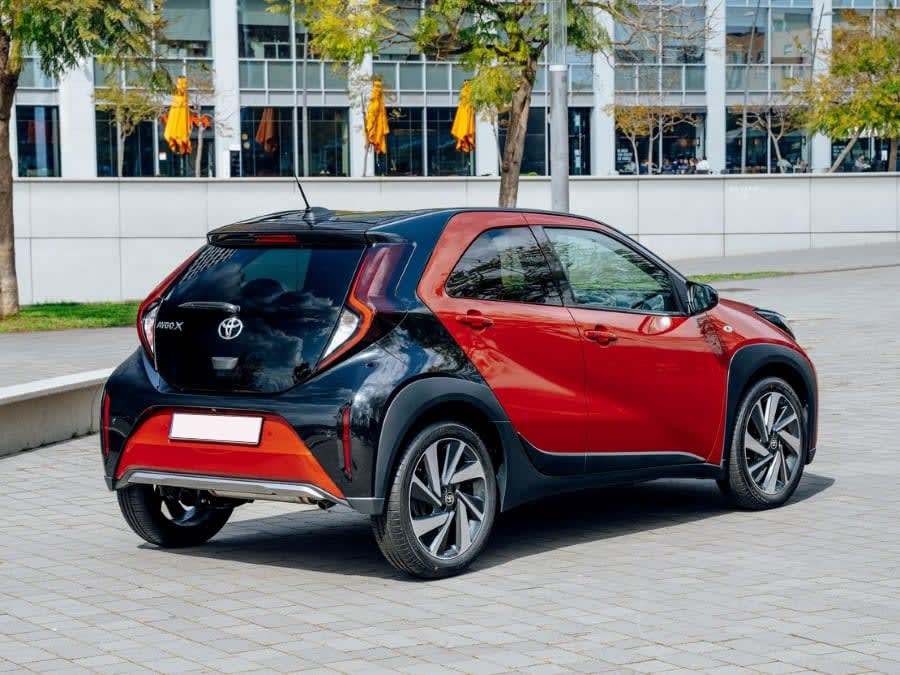
This also extends to the rear, which is shapely, enabling the rear bumper to protrude from underneath the rear windscreen, which is bigger than you would imagine. Indeed, the rear window dominates the back end so much that the Toyota badge is glued onto it. This means that, apart from the bumper, there isn’t much else to talk about.
Much of the back end is shaded in black, contrasting against the main red body colour of our test car. Meanwhile, the rear lights extend around the perimeter of the large rear window.
Although some may think it is over-sculpted and excessive, the vehicle looks unique and full of personality. But at least it is a memorable look.
Although the Aygo X is more expensive than the standard Aygo, it may not be more costly to lease. Toyota expects hire costs to be very similar, as they are worked out based on a car's predicted resale value at the end of the leasing period. And the current high popularity of crossovers should mean it holds its value better.
Key Features
There are four trims to choose from.
The entry-level ‘Pure’ gets you 17-inch alloys, a seven-inch multimedia display with Apple CarPlay/Android Auto and four speakers. It also boasts heated door mirrors, a height-adjustable driver seat, adaptive cruise control, a leather steering wheel, air conditioning and a stop/start system.
Next up is the ‘Edge’, which upgrades the infotainment display to eight inches, adds privacy glass on the rear side windows, halogen front fog lamps, and a piano black front grille. In addition, you get a choice of blue, red or ‘ginger beige’ on the rear bumper and blue stitching on the gear lever. What is more, coloured surrounds on the interior air vents and automatic air conditioning are part of the package.

The ‘Exclusive’ trim upgrades the alloys to 18-inches, adds projector LED headlamps, a nine-inch HD infotainment display, and a wireless mobile phone charger. Plus, there are parking sensors and a coloured insert on the dashboard.
The top of the range ‘Limited Edition’ gets you 18-inch matte black alloy wheels, Limited Edition logos on the C-pillar and heated driver and passenger seats.
Regardless of which grade you select, there is a choice of only one engine – a 1.0-litre three-cylinder petrol. This power unit comes with either a five-speed manual or a CVT gearbox, producing 72PS. The nought to 62mph time is sluggish 14.9-seconds, and the Aygo X’s top speed is 98mph.
Despite its styling hinting at SUV-like credentials, the small car is front-wheel drive only.
Nevertheless, this is an engine long used by Toyota. Therefore, it should be reasonably refined and reliable, not to mention cost-effective to run, thanks to its small size.
Performance & Drive
As the zero to 62mph time and the top speed both suggest, performance is not what the Aygo X is all about.
There is little torque noticeable from a standing start. The engine takes ages to get going, and if you are in the wrong gear, you will know about it as the Toyota stops making progress.
Taking the best part of 15-seconds to get up to motorway speeds is painfully slow. But it is around town where the tiny Toyota’s benefits become more evident.
The raised ride height improves visibility compared with the standard Aygo, meaning the driver sits a good 5cm higher up. This helps when navigating busier roads where there are pedestrians about.
Despite the SUV body styling, the Aygo X is intended as an around-town runabout. It is perfect for the stop-start congestion of urban centres, and it is ideal for dropping the kids off at school and then heading off to the supermarket.

You don't notice the sluggishness anywhere near as much at low speeds. However, the addition of an electric motor would solve some of its shortcomings if this were a hybrid.
The Aygo X’s size and feather-like mass (it barely weighs a tonne) mean it can quickly navigate a city centre's twists and turns, darting in and out of traffic on ring roads. Generally, it feels agile, playful, and full of character, helped by its cheerful interior – and even more so by its Yaris underpinnings.
The steering is light, but not excessively so. Therefore, it is easy to drive and doesn’t become arduous no matter how many changes of direction you need to make.
Yes, the higher ride height means you get more body roll compared with the standard Aygo, but it is well controlled. And, given the poor state of some of Great Britain’s roads, the upside is it improves the ride comfort. It also means the endless number of creases and potholes you will encounter on your journey will be smoothed out with considerable ease.
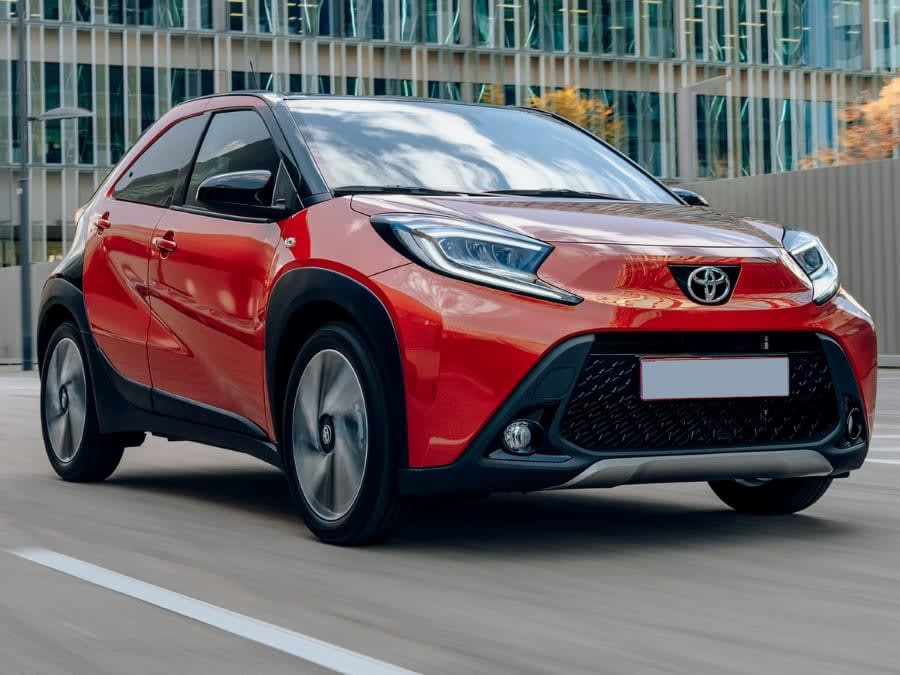
The Toyota’s suspension is quite springy, but it feels well-planted and pliant, helped by its lightweight nimbleness.
Whether you should opt for the five-speed manual or the CVT gearbox depends more on your preferences. The CVT can effectively be regarded as an automatic, as there is only one gear, so there are no gears to change. Therefore, that is one less thing to fret about if you are in stop-start traffic all the time.
Even in the manual, though, the engine tends to scream a bit when pushed, and the CVT will only make the noise worse. Toyota has done an okay job with the CVT, but we would stick with the standard manual.
If you do choose the CVT, you will get paddle shifts, which means you can effectively operate it as a manual. But in a car with such slothful performance, we can't see the point unless you have undiscovered secret aspirations to be an F1 driver.

Nevertheless, the CVT certainly does make things more convenient, plus you never need to sweat about being in the wrong gear.
Wind and tyre noise is not all that noticeable, although you will hear it more at higher speeds, which is to be expected.
There is nothing ground-breaking about the driving experience, or the car itself for that matter. But as an ‘A to B’ vehicle that is inexpensive, the Aygo X ticks all the right boxes.
Running Costs & Emissions
The advantage of having an underpowered engine is that it is unlikely to be a gas-guzzler - and that is unquestionably the case here.
With the five-speed manual gearbox, you will get a claimed 60.1mpg, although this drops to 57.6mpg with the CVT gearbox. You will likely get less than this in the real world, though, especially if you mainly drive around town.
Emissions-wise, the Aygo X manual produces 107g/km of CO2, with the CVT generating slightly more at 110g/km of CO2.

Insurance is likely to be cheap. But given there are so many all-electric, zero-emissions cars nowadays, there are more attractive company cars as far as Benefit in kind tax is concerned. Meanwhile, that lack of hybridisation technology means you won’t get the benefits of reduced road tax, which stands at £170 for the first year and £165 a year after that.
At least maintenance costs are likely to be low, though.
Interior & Technology
Much like the Aygo X’s exterior, the Toyota’s interior looks smart and is full of personality.
There are many ovals, including the vent surrounds, the gear lever surround and, most noticeably, the middle of the dashboard. Here, a large, rounded chunk has been carved out to make room for the infotainment screen, which is buried within. Coloured accents in most models add some flavour (they are orange on our test car), but you do get a choice.
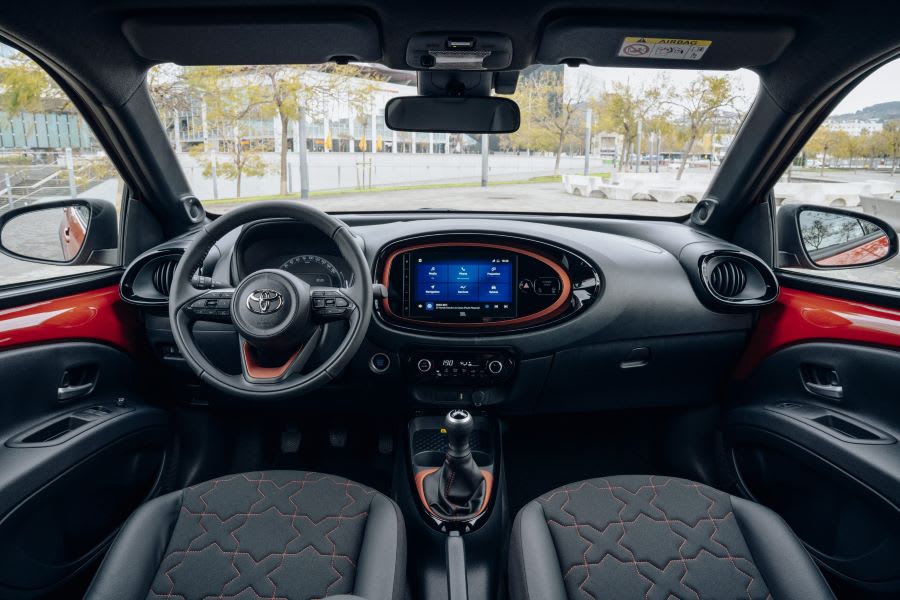
The infotainment system is functional but nothing to write home about. It isn't class-leading by any stretch of the imagination. However, if you use Apple CarPlay or Android Auto, you really won’t notice much.
Physical dials and controls sit underneath the system. For example, this real switchgear operates the air conditioning. We imagine budget considerations stopped Toyota from integrating them into the infotainment system rather than preference. But given infotainment touchscreens are challenging to use on the fly, we are grateful to Toyota that it didn’t.
The well-decorated cabin does distract from the fact that it is obviously built to a price. Cheap, hard, scratchy plastics are never far away. And, if you tap the bits that do look nice, you will see that many of them feel thin and flimsy, too, despite looking nice.
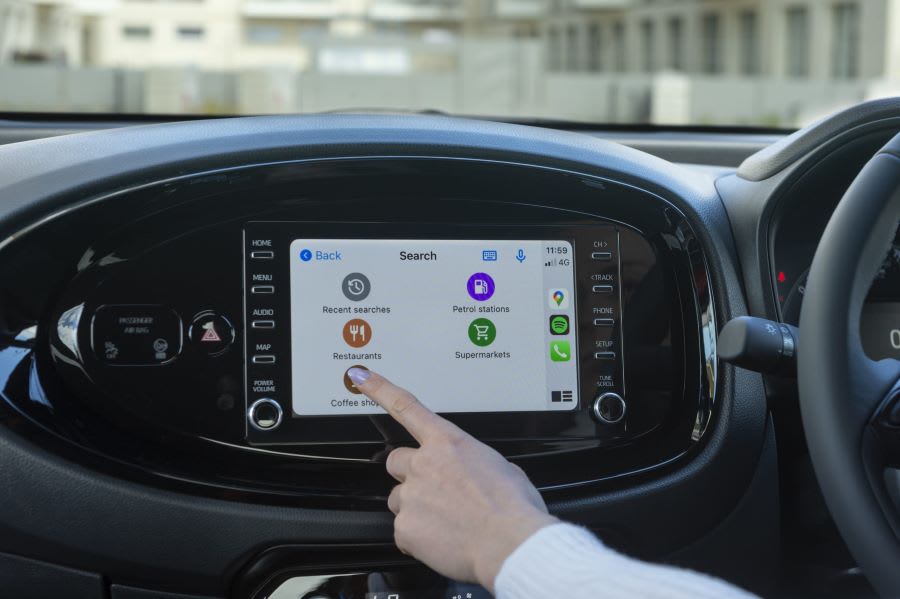
The instrument display behind the wheel is basic and largely analogue (apart from a small screen), but it is clear and informative. Despite the materials on offer, the whole interior still feels of decent build quality.
Several elements of the cabin are lifted from the Yaris, including the climate control system and the steering wheel. The latter features plenty of buttons to adjust things on the move, so Toyota has done a fine job overall.

Practicality & Boot Space
The seats are comfy, and there is a surprising amount of space in the front, with a civilised amount of headroom. Despite the car’s small proportions, you won’t be banging shoulders with the front seat passenger.
The rear is a different story, though. The legroom and headroom are limited, so small children or shopping are the only two things you will want to use it for. The rear side windows are minuscule, too, making things seem gloomy on longer journeys.
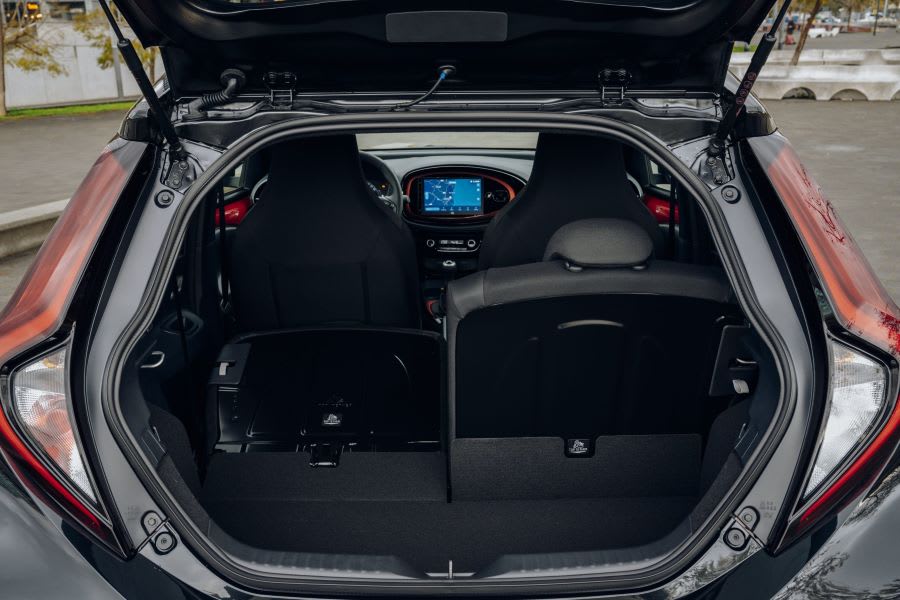
Nevertheless, 231-litres of boot space are offered, which should be satisfactory for a trip to the supermarket. But a sizeable boot lip makes getting bulkier items in and out a little challenging.
However, the cargo capacity is around 45 litres more than you get in a Fiat 500. Furthermore, volume increases to 829-litres, with the rear seats folded away in a rather unusual 50/50 split.
Safety
Safety body Euro NCAP hasn’t yet tested a Toyota Aygo X. Mind you, the standard Aygo only scored a three-star rating when it was assessed back in 2017.
It scored 74 per cent for adult occupants, 63 per cent for children but only 25 per cent for safety assists. Therefore, the latter likely lost it some marks. All that said, the Aygo X has moved forward in this respect, so the standard Aygo’s scores are unlikely to be too representative.

In addition, the Aygo X is more based on the Yaris, which earned a five-star rating. It scored much more favourably, at 86 per cent for adults, 81 per cent for children and 85 per cent for safety assists.
The Aygo X comes with lane trace assist, a pre-collision system with pedestrian and cyclist detection and an emergency steering assist system. Meanwhile, adaptive cruise control is included throughout the range, and Exclusive and Limited-Edition trims get front and rear parking sensors, which are optional extras on the Edge trim.
Options
Toyota offers only a few options for the Aygo X.
The entry-level Pure trim comes with white solid paint, although metallic colours – silver and black – both cost a few hundred pounds extra.
The Edge trim offers three metallic colours as standard: ‘Ginger Beige’, Cardamon Green, and Juniper Blue, while Chili Red pearlescent paint will set you back three figures. You can add front and rear sensors with the Parking Pack, while a canvas roof costs just shy of a grand.
The Exclusive trim has the same selection of body colours, and the parking sensors are already included. Moreover, the above-mentioned canvas roof is offered for the same price, while the JBL Premium Sound System with five speakers is just a few hundred extra notes.
The Limited trim is only available in Cardamon Green metallic paint and includes everything else as standard, so there are no options offered.

Rival Cars
Likely alternatives to the Aygo X are the personality-focused Fiat 500, the Hyundai i10 and the Kia Picanto.
While the Fiat offers the character, the Hyundai and Kia are more practical.
A Suzuki Ignis and Fiat Panda Cross are also worth looking at for those attracted to the SUV styling.

Verdict & Next Steps
Overall, the Toyota Aygo X is a loveable car that is full of personality.
We are not sure about the looks, but at least you can't call it forgettable or bland. And, to drive, you can make good progress without feeling like your hair (or beard) is on fire.
The powerplant isn't much to write home about. So, if you will spend most of your time driving at 50mph+, you are best off checking out another car from our extensive list.
There are other challengers out there with hybrid technology on them, too. What is more, the Aygo X’s rear seats aren’t suitable for anything other than small children or shopping bags.
But this Japanese miniature motor is very well-equipped for its price; it is smooth to drive and has lots of factory-fitted safety tech.
If you need a small and agile runabout for shopping in town or for the school run, this car is a serious contender.
Where to next?
View our latest Toyota Aygo X Leasing Deal - from just £175.87 per month inc VAT**
Looking for a great leasing deal? Check out our incredible range of Special Offers
New Hatchback? Read our latest Car Reviews and find the right model for you
Want to know more about leasing? Take a look at our comprehensive Leasing Guides
Interested in everything motoring? Why not catch up on all the latest Car Leasing News.
*Score based on Select’s unique meta score analysis, taking into account the UK’s top five leading independent car website reviews of the Toyota Aygo X
**Correct as of 27/04/2022. Based on 9 months initial payment, 8,000 miles over a 48 month lease. Initial payment equivalent to 9 monthly payments or £1,582.83 Ts and Cs apply. Credit is subject to status.






















